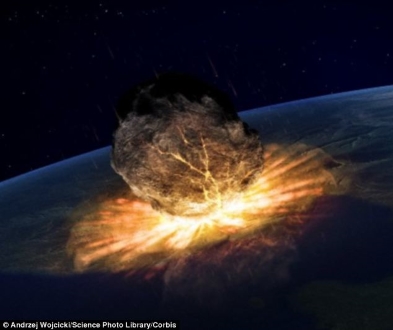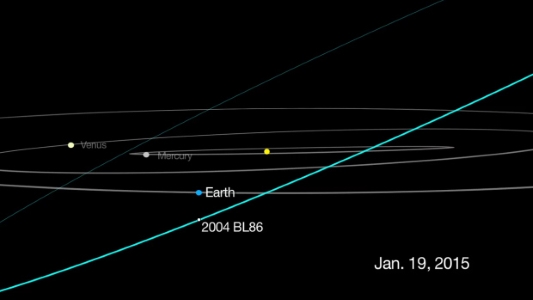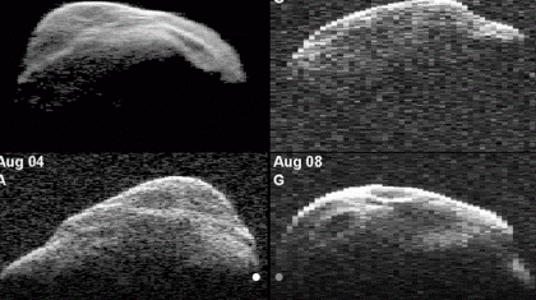 Nasa won’t meet its goal to find 90 percent of potentially dangerous asteroids larger than 460ft (140 metres) in diameter, the agency’s Inspector General said
Nasa won’t meet its goal to find 90 percent of potentially dangerous asteroids larger than 460ft (140 metres) in diameter, the agency’s Inspector General said
WARNING! Huge Asteroid Heading To Earth – Will Be Visible With Binocular
Because a huge asteroid is hurtling towards Earth – and experts don’t know how to stop it
- Asteroid 1950 DA has a 0.3 per cent chance of hitting Earth in 867 years
- A possible impact date for 1950 DA is on 16 March, 2880, scientists say
- If it hits, it would do so with a force of 44,800 megatonnes of TNT
- But scientists say there is no cause for concern as the risk is low
- Asteroid’s body defies gravity due to forces known as van Der Waals
- These forces have never been spotted on an asteroid before
- Scientists say they are now closer to finding out how to stop the rock
The date of Earth’s potential destruction has been set at 16 March 2880, when an asteroid hurtling through space has a possibility of striking our planet.
Researchers studying the rock found that its body rotates so quickly that it should break apart, but somehow remains intact on its Earth-bound trajectory.
They believe it is held together by cohesive forces known as van der Waals – and although this is considered a major breakthrough, scientists still don’t know how to stop it.
The discovery was made by researchers at the University of Tennessee (UT), Knoxville.
Previous research has shown that asteroids are loose piles of rubble held together by gravity and friction.
However, the UT team found that the asteroid, called 1950 DA, is spinning so quickly that it defies these forces.
It is approximately 3,280ft (1,000 metres) in diameter, but rotates once every two hours and six minutes.
At this rate, the rock should break apart and eventually disintegrate, but it is not showing any signs of doing so.
WHAT IS ASTEROID 1950 DA?
The asteroid, named 1950 DA, is a rock two-thirds of a mile in diameter, travelling at about 15 km (nine miles) per second relative to the Earth.
It is approximately 3,280ft (1,000 metres) in diameter, but rotates once every two hours and six minutes.
At this rate, the rock should break apart and eventually disintegrate, but it is not showing any signs of doing so.
In fact, the rotation is so fast that at its equator, 1950 DA effectively experiences negative gravity.
If an astronaut were to attempt to stand on this surface, he or she would fly off into space unless he or she were somehow anchored.
The presence of cohesive forces has been predicted in small asteroids, but definitive evidence has never been seen before.
It is due to swing so close to Earth it could slam into the Atlantic Ocean at 38,000 miles per hour.
It is estimated that if 1950 DA were to collide with the planet, it would do so with an force of around 44,800 megatonnes of TNT.
Although the probability of an impact is only 0.3 per cent, this represents a risk 50 per cent greater than an impact from all other asteroids.(source)
An asteroid or meteor will hit the earth on September 24, 2015 – you have been warned!!!
Giant Asteroid Headed Toward Earth Will Be Visible With Binoculars
 This graphic depicts the passage of asteroid 2004 BL86, which will come no closer than about three times the distance from Earth to the moon on Jan. 26, 2015. Due to its orbit around the sun, the asteroid is currently only visible by astronomers with large telescopes who are located in the southern hemisphere. But by Jan. 26, the space rock’s changing position will make it visible to those in the northern hemisphere. (NASA/JPL-Caltech)
This graphic depicts the passage of asteroid 2004 BL86, which will come no closer than about three times the distance from Earth to the moon on Jan. 26, 2015. Due to its orbit around the sun, the asteroid is currently only visible by astronomers with large telescopes who are located in the southern hemisphere. But by Jan. 26, the space rock’s changing position will make it visible to those in the northern hemisphere. (NASA/JPL-Caltech)
NASA estimates the asteroid will safely pass about three times the distance of Earth to the moon, or about 745,000 miles. That’s close enough for amateur astronomers to observe the hunk of rock with small telescopes and strong binoculars.
“While it poses no threat to Earth for the foreseeable future, it’s a relatively close approach by a relatively large asteroid, so it provides us a unique opportunity to observe and learn more,” NASA’s Near-Earth Object Program said in a statement.
Scientists at NASA’s Deep Space Network antenna in Goldstone, Calif., and at the Arecibo Observatory in Puerto Rico plan to learn more about the asteroid, called 2004 BL86, with radar-generated images during the days surrounding its closest approach to Earth.
 Radar observation of 1999 JM8 taken on August 3, 1999 with the Arecibo radar. The image reveals an asymmetric, irregularly-shaped object. (NASA)
Radar observation of 1999 JM8 taken on August 3, 1999 with the Arecibo radar. The image reveals an asymmetric, irregularly-shaped object. (NASA)
“I may grab my favorite binoculars and give it a shot myself,” said Don Yeomans, who is retiring as manager of NASA’s Near Earth Object Program Office at the Jet Propulsion Laboratory in Pasadena. “Asteroids are something special. Not only did asteroids provide Earth with the building blocks of life and much of its water, but in the future, they will become valuable resources for mineral ores and other vital natural resources.”
NASA’s Near-Earth Object Program detects, tracks and characterizes asteroids and comets using both ground and space-based telescopes to determine if their close approaches could be potentially hazardous to our planet.(source)
WARNING! Huge Asteroid Heading To Earth
Hope for the best, but prepare for the worst.
This is a good motto to live by, despite how you think about things.
Individuals can still hope for the best (that things can and will eventually work out), but what
good is your prosperity going to do if you don’t have anything to eat or a safe place to hang out
for an extended period of time?
Why not prepare while you still can — when things are readily available and can still be
purchased at cheap prices? The coming hyper-inflation will make any such purchases beforehand
look very intelligent…
To prepare for the worst, you need a plan. Why are most people so against doing basic
preparations that could be the difference on how they survive — or whether they survive?
History shows time and again that those who prepare always fare better than those who did not.
Having a plan and being determined to act on that plan will always be the best way to handle any
contingencies, should they occur.
After disaster strikes, your mind is going to be racing around like a car on a race track. Preplanning and having a written set of measures to take will make someone’s life go much
smoother when the SHTF.
Survival MD (Best Post Collapse First Aid Survival Guide Ever)
Backyard Innovator (A Self Sustaining Source Of Fresh Meat,Vegetables And Clean Drinking Water)
Blackout USA (EMP survival and preparedness)
Conquering the coming collapse (Financial advice and preparedness )
Liberty Generator (Build and make your own energy source)
Backyard Liberty (Easy and cheap DIY Aquaponic system to grow your organic and living food bank)
Bullet Proof Home (A Prepper’s Guide in Safeguarding a Home )
Family Self Defense (Best Self Defense Strategies For You And Your Family)
Sold Out After Crisis (Best 37 Items To Hoard For A Long Term Crisis)
Survive The End Days (Biggest Cover Up Of Our President)


